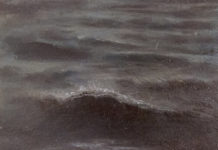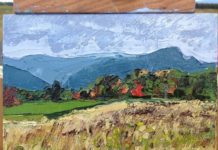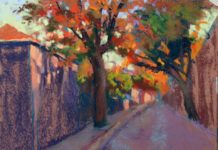
There is a field in Massachusetts near where Christine Labich lives that captivates her, and her exceptional pastel pieces from the location verify her choice. What makes it so great?

“Late Summer Gap,” by Christine Labich, pastel, 11 x 13 in.
“The cliffs go into shadows, and the shadows from the hills form an incredible backdrop for a line of trees in front,” Labich says rapturously. “There are often shades of blue and purple in the hills and electric greens in the foreground.” The artists has been painting this spot for seven years; she discovered it on one of her many drives to deliver her kids to activities. Labich says that people stop along the road overlooking the field and eat their lunch there, gazing out at the beautiful scene from the slight rise of the road. Labich returns there in all seasons. “I paint all along the road at different angles, depending on what the light is doing and what my mood is,” she says. “Mostly I paint toward the hills. Sometimes I zoom in to one group of trees, and sometimes I compose the painting with a lot of sky in it.”

“Late Summer Gap” in progress and the view that inspired it

Labich’s favorite place to paint

“Moody Bridge Road, November,” by Christine Labich, pastel, 9 x 12 in.

“Spring, Through,” by Christine Labich, pastel, 11 x 13 in.
Labich’s love of rural landscapes has roped her into the conservation movement. “Last summer, this field was divided into four house lots and put on the market, and a large group of us who love it and see it as iconic to our area supported our local Land Trust to buy the development rights,” she says. “It is now part of the Silvio Conte National Wildlife Refuge and won’t be developed.” She was trained as a conservation biologist, so her concern is not completely surprising. “This is a really incredible area for farmland,” she points out. “The community support for agriculture is strong — there’s great farmland along the Connecticut River. This made me realize that farmland is as important to conserve as forests. Once you disturb all that soil and pave it over, you can never get it back; the fertility of the land is affected.”

Shadows on the hills

“Green Gap,” by Christine Labich, pastel, 11 x 13 in.

“Hills Beyond (Purple and Green),” by Christine Labich, pastel, 12 x 9 in.
Labich doesn’t use an umbrella, because the area is notoriously windy. She finishes most pieces in 90 minutes. “The light tells me when it’s time to go,” says the artist. Pastel calls for a slightly different approach than oils. “I generally block in an underpainting of darks and lights first, usually in related colors,” reports Labich. “So there might be light purple in the sky and dark purple in the trees. It doesn’t have so much to do with the light changing, it’s just the way I like to work. I go lightly over dark areas to imitate sunlight and make the forms. Then I spend a lot of time thinking about the tones that I want to express in the landscape that are not the final tone that I will present, but what is underneath. For things like the sunlight hitting the tops of trees, I use a very light touch.”




